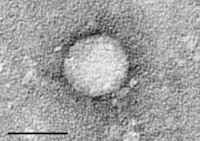
Photo from wikipedia
Hepatitis E virus (HEV) is a leading cause of viral hepatitis in the world. It is usually responsible for acute hepatitis, but can lead to a chronic infection in immunocompromised… Click to show full abstract
Hepatitis E virus (HEV) is a leading cause of viral hepatitis in the world. It is usually responsible for acute hepatitis, but can lead to a chronic infection in immunocompromised patients. The host’s innate immune response is the first line of defense against a virus infection; there is growing evidence that HEV RNA is recognized by toll-like receptors (TLRs) and retinoic acid-inducible gene I (RIG-I)-like receptors (RLRs), leading to interferon (IFN) production. The IFNs activate interferon-stimulated genes (ISGs) to limit HEV replication and spread. HEV has developed strategies to counteract this antiviral response, by limiting IFN induction and signaling. This review summarizes the advances in our knowledge of intracellular pathogen recognition, interferon and inflammatory response, and the role of virus protein in immune evasion.
Journal Title: Vaccines
Year Published: 2020
Link to full text (if available)
Share on Social Media: Sign Up to like & get
recommendations!